
Imperial Airways was an early British commercial long-range airline, operating from 1924 to 1939 and principally serving the British Empire routes to South Africa, India, Australia and the Far East, including Malaya and Hong Kong. Passengers were typically businessmen or colonial administrators, and most flights carried about 20 passengers or fewer. Accidents were frequent: in the first six years, 32 people died in seven incidents. Imperial Airways never achieved the levels of technological innovation of its competitors and was merged into the British Overseas Airways Corporation (BOAC) in 1939. BOAC in turn merged with the British European Airways (BEA) in 1974 to form British Airways.
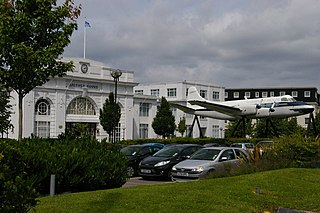
Croydon Airport was the UK's only international airport during the interwar period. It opened in 1920, located in Croydon, then part of Surrey. Built in a Neoclassical style, it was developed as Britain's main airport, handling more cargo, mail, and passengers than any other UK airport at the time. Innovations at the site included the world's first air traffic control and the first airport terminal. During World War II the airport was named RAF Croydon as its role changed to that of a fighter airfield during the Battle of Britain; and in 1943 RAF Transport Command was founded at the site, which used the airport to transport thousands of troops into and out of Europe.
The Bombay Flying Club is the oldest flying club in India, established in 1928, located at Juhu aerodrome, Mumbai. At present, the Bombay Flying Club's College of Aviation offers programs such as pilot training, Aircraft Maintenance Engineer, and cabin crew, approved by the Directorate General of Civil Aviation (DGCA), and also BSc Aviation and BSc Aeronautics programs with affiliation from the University of Mumbai.
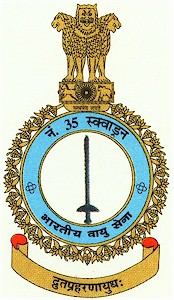
No. 35 Squadron IAF (Rapiers) was an electronic warfare and air superiority squadron of the Indian Air Force (IAF). It was based at Bakshi Ka Talab Airforce Station, No. 35 Squadron came under the Central Air Command; and along with No. 108 Squadron formed an operational wing of the IAF. As of 2017, it was equipped with MiG-21M aircraft. The squadron was number plated in 2019.

The Royal Indian Air Force (RIAF) was the aerial force of British India and later the Dominion of India. Along with the Indian Army, and Royal Indian Navy, it was one of the Armed Forces of British Indian Empire.

Air Marshal Subroto Mukerjee OBE was an Indian military officer who was the first Indian Commander-in-Chief (C-in-C) of the Indian Air Force. He was awarded several honours during the course of a three-decade-long career, ended by his untimely demise in 1960. He has been called the Father of the Indian Air Force.
The No.3 Squadron (Cobras) of the Indian Air Force (IAF) operates as a Close Air Support (CAS) and reconnaissance unit. Currently based at NAL Air Force Station, No. 3 Sqn falls under the Western Air Command, forms the 46 wing of the IAF.
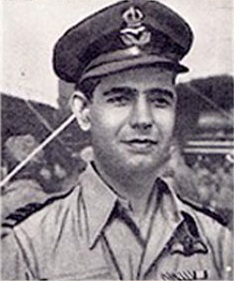
Air Marshal Aspy Merwan Engineer DFC was an officer in the Indian Air Force who rose through the ranks to become independent India's second Chief of the Air Staff, succeeding Subroto Mukerjee in 1960 and preceding Arjan Singh.

The Indian Air Force Test Pilot School is a unit of the Indian Air Force (IAF) that evaluates aircraft and systems for induction into user organisations. Most new aircraft types and major airborne systems must have ASTE's stamp of approval to be considered fit for service in India. While many countries have testing facilities of one kind or the other, training of flight test personnel is not often imparted in them. ASTE's Air Force Test Pilots School (AFTPS) is only the fifth such institution in the world.
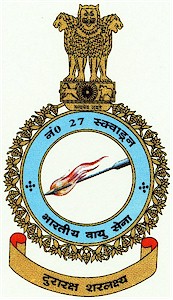
No. 27 Squadron IAF is a Ground-Attack and Close Air Support squadron of the Indian Air Force, operating from Gorakhpur AFS, under Central Air Command.

Charles Douglas Barnard was a British pilot, who took part in 1920s air races and record-breaking flights.
Air Marshal Minoo Merwan Engineer, PVSM, MVC, DFC was a former Air Officer in the Indian Air Force. He is one of the most decorated officers in the Indian Air Force, with the second-highest civil decoration - the Padma Bhushan, two gallantry awards - the Maha Vir Chakra and the Distinguished Flying Cross, and the highest peace-time distinguished service award - the Param Vishisht Seva Medal.
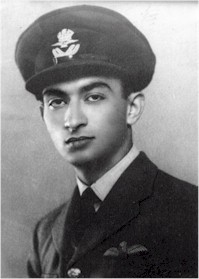
Flying Officer Dinshaw Ferozeshaw Eduljee, AFC was a former officer of the Indian Air Force (IAF). He was the first pilot of the IAF to receive the Air Force Cross, on 1 June 1944. Eduljee is presumed to have died after the Hurricane fighter aircraft he was flying crashed in action behind Japanese lines in Burma. The circumstances and time of his death are not known.

Air Chief Marshal Hrushikesh Moolgavkar, PVSM, MVC was a former Air officer in the Indian Air Force. He served as the 9th Chief of the Air Staff of the Indian Air Force from 1 February 1976 till 31 August 1978.
Aviation in India can be broadly divided into military and civil aviation. India has an extensive civilian air transportation network and is amongst the fastest-growing aviation markets in the world according to the International Air Transport Association (IATA).
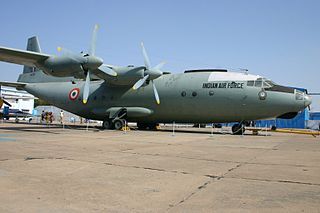
On 7 February 1968, an Antonov An-12 turboprop transport aircraft of the Indian Air Force piloted by Flight Lieutenant Harkewal Singh and Squadron Leader Pran Nath Malhotra, disappeared while flying to Leh Airport from Chandigarh. Flight 203 was on approach to Leh when the pilot decided to turn back due to inclement weather, the aircraft then went missing with the last radio contact over the Rohtang pass. It was declared missing after the failure to find the wreck.

Man Mohan Singh, also spelled Manmohan Singh, was an early Indian aircraft pilot who, in 1930, was the first Indian to fly solo from Croydon Airport, England, to Karachi, India.

Air Vice Marshal Harjinder Singh, PVSM, MBE was an Air Officer in the Indian Air Force. He was one of the earliest to join the newly created Indian Air Force (IAF) in 1933 in the lowest rank of 'Hawai sepoy'. In a career spanning over three decades and two wars, he rose from the lowest enlisted rank to the then second-highest rank in the Indian Air Force. Hailed as technical wizard and innovator, he is considered a legend of the IAF.
Air Commodore Narendra was an officer of the Indian Air Force (IAF). One of the pioneers of the IAF, he last served as the Air Officer-in-charge Technical and Equipment Services at Air HQ. He was killed when his Dakota aircraft crashed near Gülnar in Southern Turkey. At the time of his death, he was the third senior-most officer of the IAF, after Air Marshals Subroto Mukerjee and Aspy Engineer.














